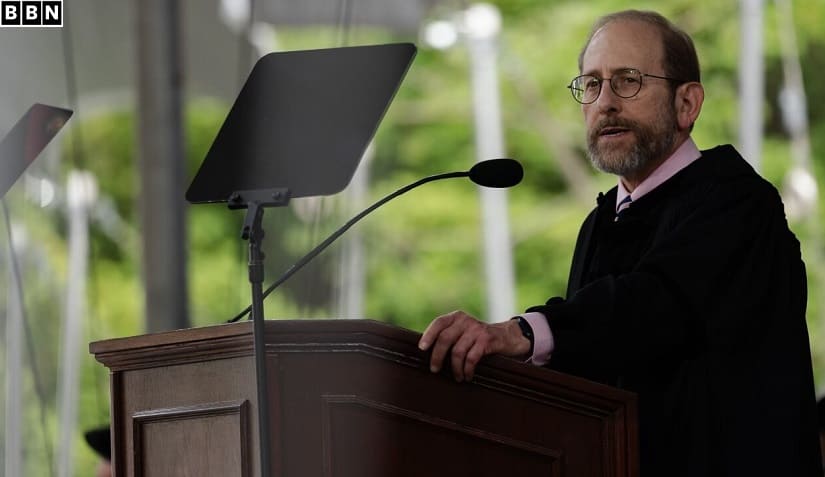Harvard President Alan Garber Challenges Trump While Embracing Cultural Reform
WASHINGTON, D.C. — In a time of deepening conflict between elite academic institutions and the federal government, Harvard University has found itself at the epicenter. Its new president, Dr. Alan Garber, is navigating a high-stakes balancing act — defending the university against aggressive moves by the Trump administration while quietly pushing through cultural reforms that, ironically, echo conservative criticisms of campus life.
Dr. Garber, who assumed full presidential responsibilities after the resignation of Claudine Gay, has publicly opposed what he describes as federal overreach. The administration is threatening to cut over $2 billion in research funding and revoke Harvard’s nonprofit tax status, citing the university’s handling of antisemitism and ideological diversity. Yet, in rare public comments, Dr. Garber has acknowledged that some of the criticisms leveled by the Trump administration are not without merit.
“There are real issues on this campus that we cannot ignore,” Garber said during an extended interview in Washington. “The culture here needs to change.”
A Unifying Yet Divisive Figure
Garber’s rise to the presidency came during a period of institutional turbulence. A health economist by training and a seasoned Harvard provost for over a decade, he is no stranger to academic bureaucracy. But his new role has thrust him into a politically charged national spotlight.
In liberal circles, he has earned praise for resisting what many see as an authoritarian push from Washington. In April, he issued a scathing public letter rejecting a sweeping list of federal demands that included auditing Harvard’s admissions and hiring processes for ideological balance — a move he said crossed constitutional lines.
“No government — regardless of which party is in power — should dictate what private universities can teach or whom they can admit and hire,” Garber wrote.
But while Garber is publicly defending Harvard’s independence, he is also working to correct what he sees as internal failures. These include longstanding concerns over free speech, political intolerance, and the university’s response to antisemitism.
Internal Reforms Reflect External Pressure
In recent months, Garber has initiated a series of policy reversals. He ended university support for separate graduation ceremonies for groups like Black, Latino, and LGBTQ students — a move welcomed by some and criticized by others as capitulating to conservative pressures. He has also emphasized the importance of enforcing campus rules against harassment and disruptive protests, particularly those involving antisemitic incidents.
Harvard’s psychology professor Steven Pinker, a frequent critic of ideological conformity on campus, praised Garber’s willingness to confront difficult truths. “He’s showing courage in addressing issues many university leaders still avoid,” Pinker said.
Critics, however, argue that these policy shifts are more about optics than substance. A student editorial in The Harvard Crimson warned that such measures may placate critics temporarily but risk undermining Harvard’s foundational values.
A Pragmatist in a Hostile Landscape
Dr. Garber’s career is defined by quiet pragmatism rather than showmanship. Before returning to Harvard, he spent decades in California as a researcher and physician. As provost, he built a reputation as a thoughtful, consensus-driven administrator.
He didn’t seek the presidency. In fact, he had planned to return to teaching. But when Harvard’s leadership vacuum became a crisis, Garber stepped in. Now, he is leading the university through one of its most contentious periods in decades.
He has refused to escalate hostilities with the federal government unnecessarily. After initial threats from Washington, he responded with restraint, outlining the university’s existing and planned efforts to curb antisemitism. But when new demands arrived in April — including audits of student and faculty political leanings — Garber responded with open defiance.
“This is not regulation. This is control,” he said.
Rebuilding Trust in Higher Education
Garber is acutely aware that the stakes go beyond Harvard. Polls show declining public trust in American universities. Many Americans view elite institutions as politically biased and culturally detached. Garber sees this distrust as a danger not just to Harvard but to the broader ecosystem of research and education.
“Universities have always been engines of innovation and progress in this country,” he said. “But we must be worthy of the public’s trust.”
His recent actions reflect an attempt to reconcile that need for trust with the university’s identity. Harvard is scaling back its involvement in politically charged public statements and reassessing how it incorporates diversity into hiring and admissions.
Some view this recalibration as overdue. Others see it as a retreat. But Garber insists it’s about principle, not pressure.
“We are focusing on individuals and their unique qualities,” he recently said. “Race and identity are important, but they should not overshadow merit or personal story.”
A Presidency Under Fire — And in Focus
Whether Garber’s strategy will succeed remains uncertain. He faces resistance from students, criticism from alumni, and intense scrutiny from the federal government. Yet, many within Harvard’s community say they are beginning to rally behind him, recognizing the magnitude of the challenge he faces.
“He is trying to save this university from both internal complacency and external aggression,” said Dr. Jeffrey Flier, former dean of Harvard Medical School. “That’s not an easy thing to do.”
Dr. Garber’s leadership — quiet, calculated, and cautious — may not match the fiery rhetoric of resistance heroes. But in a deeply polarized environment, it may be the kind of leadership Harvard needs.
“This is not just about Harvard,” Garber said. “It’s about whether American universities can continue to be places of independent thought, scientific progress, and public good.”
Thanks for visiting Best Breaking News

